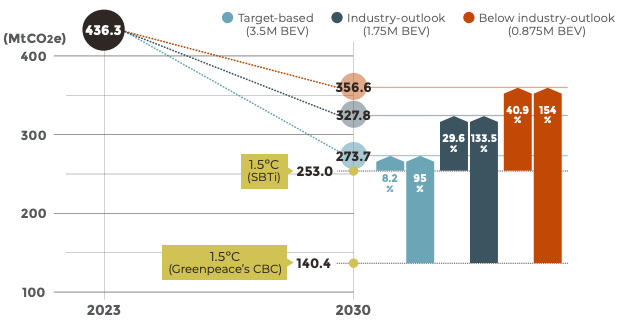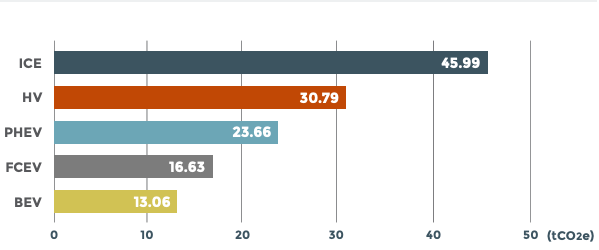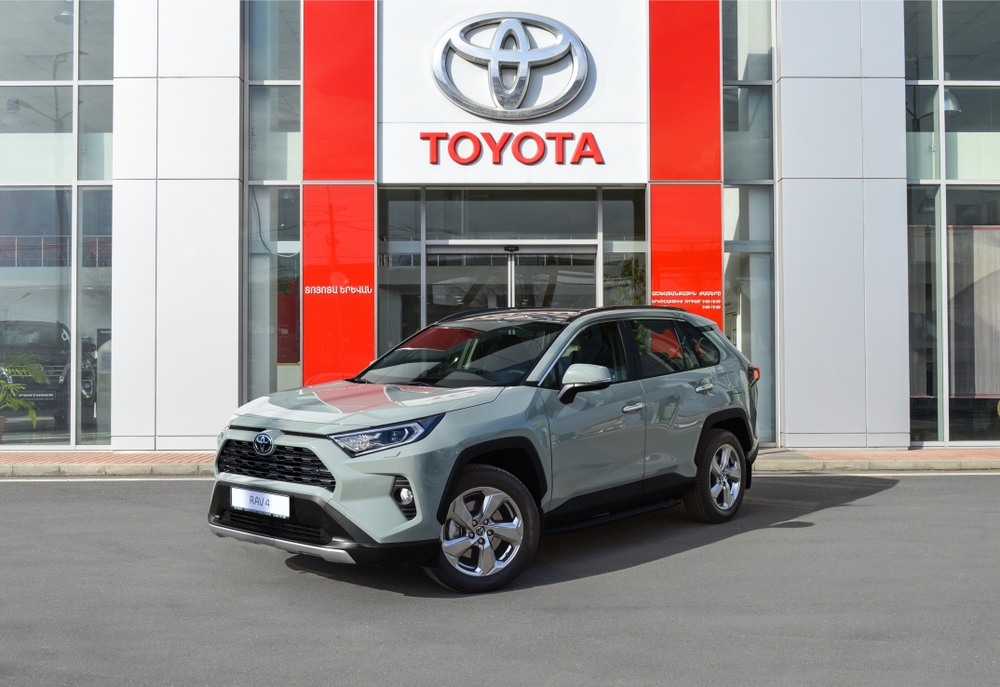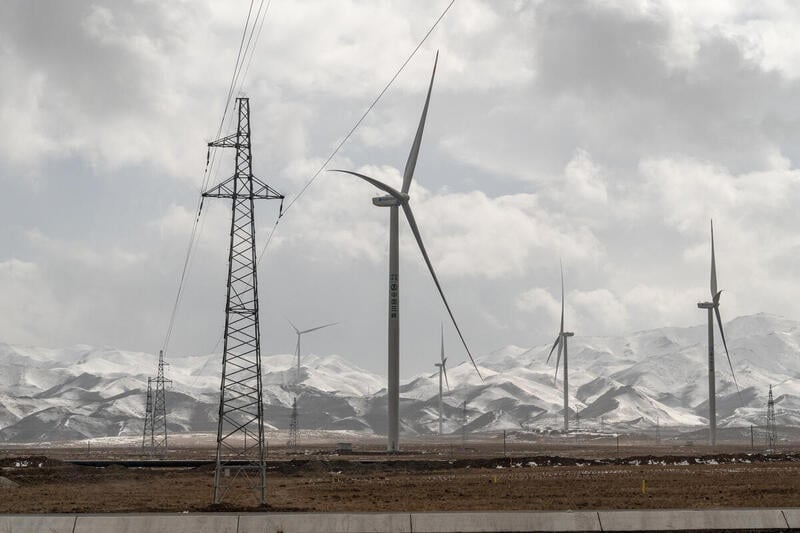TOKYO – Toyota, the world’s largest automaker, is falling dangerously behind the global 1.5°C climate target. According to a new report from Greenpeace East Asia’s Tokyo office, Toyota’s decision to scale back its battery electric vehicle (BEV) targets could result in millions of tons of avoidable carbon emissions – further worsening the climate crisis and slowing global decarbonization. In addition, Toyota’s heavy reliance on internal combustion engine (ICE) vehicle sales risks locking developing regions such as Southeast Asia and India into high-emission pathways – just as they face growing vulnerability to escalating climate impacts.
Greenpeace East Asia’s latest report, “Toyota at a Crossroads: World’s Largest Automaker’s BEV Strategy Against the 1.5°C Pathway,” analyzes Toyota’s vehicle emissions by powertrain to evaluate its progress toward near-term emission reductions for 2026 and 2030 under three different vehicle sales scenarios [1] and examines whether they align with the IPCC’s 1.5°C pathways.
The findings show that even Toyota’s most ambitious BEV targets [2] remain far below what is needed to meet the 1.5°C goal. Earlier this year, Toyota further widened this gap by halving its 2026 annual sales target from 1.5 million BEVs to 800,000 units – a decision that could lead to an additional 11.7 to 22.6 million metric tons of CO₂ emissions as compared to the original 1.5 million BEVs target. Looking ahead to 2030, even if Toyota achieves its goal of 3.5 million BEVs annually, projected emissions would still exceed the levels required to stay within the 1.5°C limit.
Mariko Shiohata, Greenpeace Japan Climate and Energy Campaigner, said:
“As one of the world’s largest car manufacturers, Toyota’s decisions have global implications. Our analysis reveals that the company has announced its BEV production plans without adequately addressing how it will reduce emissions. If Toyota truly aims to achieve net zero by 2050, it needs to develop clear scenarios and conduct backcasting to drive sustainable technology and innovation.”
“Scientists confirm that the Earth has reached irreversible climate tipping points – starting with the loss of coral reefs and accelerating toward the collapse of the Amazon and polar ice. As the world’s largest car manufacturer, Toyota must immediately demonstrate that its climate commitments align with the 1.5°C pathway. Our analysis suggests a major disconnect between the company’s current BEV sales targets and the urgent actions needed to combat climate change.”
Key Findings:
- Massive Emissions from Combustion Vehicles: In 2023, an overwhelming 98.9% of Toyota’s use-phase emissions, or 436.28 million metric tons of carbon dioxide equivalent (MtCO₂e), stemmed from conventional internal combustion engine (ICE) and hybrid vehicles. ICE vehicles emitted an average of 45.99 tCO₂e per vehicle, over three times more than battery electric vehicles (BEVs), which emitted only 13.06 tCO₂e per vehicle. Hybrids and plug-in hybrids provided only partial reductions, emitting 30.79 tCO₂e and 23.66 tCO₂e, respectively, as they still rely on fuel combustion.
- Geographical Emissions Disparities Driven by ICE Sales: In markets with heavy reliance on ICE vehicle sales, such as Asia – a key growth region and production hub for Toyota – per-vehicle and overall emissions are significantly higher. For instance, Toyota vehicles in Thailand – where most sales are ICE vehicles –emit over four times more CO₂ than those in Norway, where BEVs make up a significantly higher share of sales. These disparities underscore that Asian markets like Thailand, Indonesia, Philippines, and India – some of the most climate-vulnerable nations – will bear a disproportionate share of damage if Toyota delays its shift towards zero-emission vehicles.
- Weakened BEV Targets Threaten Climate Goals: Toyota’s decision to cut its 2026 BEV target from 1.5 million to 0.8 million units could result in an additional 11.7–22.6 MtCO₂e of potential emissions each year—roughly equivalent to the annual emissions of 4.5-8.7 million Japanese households in 2022. This regression not only undermines Toyota’s own climate pledge but also threatens to derail global decarbonization efforts. Even if Toyota followed its original plan of selling 3.5 million BEVs, its projected 2030 emissions could still reach 273.7 MtCO₂e –nearly double the level of greenhouse gases budget allowed under the 1.5°C Carbon-Budget Consistent benchmark. These findings confirm that even Toyota’s most progressive strategy is still incompatible with the pace of decarbonization required under the Paris Agreement.
- Urgent Need for a Full BEV Transition: To meet the 1.5°C climate target, Toyota must accelerate its BEV transition and completely phase out ICE vehicle sales by 2030 with clear, region-specific phaseout timelines and a rapid increase in BEV production across all of Toyota’s major markets. Without decisive action, Toyota risks straying off course from the critical pathway to limit global warming to 1.5°C.
Figure 1. Toyota’s projected 2030 use-phase emissions compared with SBTi and Greenpeace CBC benchmarks

Figure 2. Toyota’s lifetime use-phase emissions by powertrain (2023) [3]

Greenpeace urges Toyota to commit to a minimum 43% absolute reduction in emissions by 2030 (from 2019 levels) across the value chain, consistent with Intergovernmental Panel on Climate Change (IPCC) 1.5°C pathways. Greenpeace also calls on Toyota to establish transparent, time-bound BEV adoption targets, implement a clear global plan for phasing out internal combustion engine vehicles, and enhance transparency in Scope 3 emissions accounting.
“This is a pivotal moment for Toyota to realign its strategy with climate science, especially with Trump’s upcoming visit to Asia in late October, which may reignite discussions on trade and tariffs. As pressure mounts for automakers to adopt sustainable practices, Toyota must accelerate its climate commitments to stay competitive and resilient in a warming world. We urge Toyota to take decisive action – the climate crisis is urgent, and Japan, as a major car-making nation, must step up on climate solutions,” said Shiohata.
END
Notes:
The full report, Toyota at a Crossroads: World’s Largest Automaker’s BEV Strategy Against the 1.5°C Pathway, is available here.
[1] This report examines Toyota’s BEV production plans and evaluates the resulting use-phase emissions against the IPCC’s 1.5°C pathways. Expected reductions are calculated using emissions data disclosed by Toyota. The analysis is organized into four key components:
- Toyota’s 2023 vehicle sales and use-phase CO₂ emissions by market;
- Breakdown of 2023 use-phase emissions by powertrain;
- Toyota’s 2026 BEV production plan and associated emissions estimate;
- Projected 2030 emissions under alternative BEV adoption scenarios, including target-based, industry-outlook, and below industry-outlook pathways, with comparison to 1.5°C benchmarks.
To assess alignment with 1.5°C climate goals, two benchmarks are utilized: the SBTi-aligned benchmark and Greenpeace’s Carbon-Budget Consistent benchmark.
[2] Toyota initially pledged to achieve carbon neutrality by 2050 with plans to produce 1.5 million battery electric vehicles (BEVs) by 2026 and 3.5 million by 2030. However, earlier this year, the company reduced its 2026 target to 800,000 units — representing approximately a 50% cut.
[3] HV denotes Hybrid Electric Vehicle; PHEV stands for Plug-In Hybrid Electric Vehicle; and FCV refers to Fuel Cell Vehicle.
Media Contacts
Yujie Xue, International Communications Officer, Greenpeace East Asia (Hong Kong), +852 5127 3416, [email protected]
Natalia Emi Hirai, Communications Officer, Greenpeace Japan, +8180 6558 4446, [email protected]


